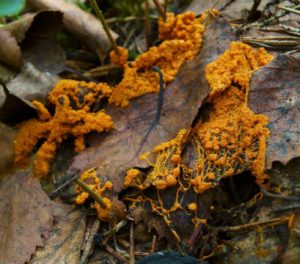Saving Memories Without a Brain
Written by: Lily Song
As human beings, having a memory of the past is an advantage we’re used to having. It’s no question that having a memory allows us to carry out day to day functions, like taking a test, memorizing a speech, or preparing a dish. Just like humans need their memory to carry out these tasks, it is crucial for animals to store and recover information for various purposes such as hunting for food or avoiding harmful environments. Furthermore, humans and animals, as well as the vast majority of multicellular organisms, have a nervous system that plays an invaluable role in many bodily functions such as memory. However, researchers at the Max-Planck Institute for Dynamics and Self-Organization (MPI-DS) and the Technical University of Munich (TUM) have now identified how the slime mold Physarum polycephalum, a puzzling, highly dynamic, single-celled organism, saves memories without a nervous system.
Physarum polycephalum
The slime mold Physarum polycephalum has been baffling researchers for many decades. Existing at the crossroads between the kingdoms of animals, plants and fungi, this unique organism provides helpful insight into the evolutionary history of eukaryotes, which is a type of cell which humans are composed from. Physarum polycephalum’s body is a single large cell made up of interconnected tubes that form intricate networks within the cell. This amoeba-like cell can stretch for several centimeters or even meters, being the largest cell discovered on Earth.
Figure 1

Image of slime mold Physarum Polycephalum
Source: stock.adobe.com
Decision making
The slime mold also has bizarre decision-making abilities, able to solve complex problems, such as finding the shortest path through a maze. The team discovered that the reason behind this phenomenon was because the organism weaved memories of food encounters directly into the architecture of the network-like body and uses the stored information when making future decisions. The slime mold’s ability is fascinating because given its tubular network, which constantly grows and breaks down its tubes, the Physarum Polycephalum has no concrete organizing system. Yet, it is still able to utilize its tubular network to its advantage by storing information for making important future decisions.
In order to dive deeper, researchers carried out a simple experimental system by following the migration and feeding process of the organism and observed a distinct imprint of a food source on the pattern of thicker and thinner tubes of the networks after feeding. Given Physarum’s highly dynamic tubular reorganization, the persistence of this imprint “sparked the idea that the network architecture itself could serve as a memory of the past,” says Karen Alim, head of the Biological Physics and Morphogenesis group at the MPI-DS and professor on Theory of Biological Networks at the Technical University of Munich. However, they first needed to explain the mechanism behind the imprint formation.
Storing Memories
In order to do this, the researchers combined the microscopic observations of the adaption of the tubular network with theoretical modeling. An encounter with food would trigger the release of a chemical that travels through where food was found in the organism to the various tubes in the networks, which then softens the tubes and causes the whole organism to reorient its migration towards the food.
“The gradual softening is where the existing imprints of previous food sources come into play and where information is stored and retrieved,” says first author Mirna Kramar. “Past feeding events are embedded in the hierarchy of tube diameters, specifically in the arrangement of thick and thin tubes in the network.”
For the softening chemical that is transported, the thick tubes in the network act as highways in traffic networks, enabling quick transport across the whole organism. Past encounters imprinted in the network thus weigh into the decision about the future direction of migration, allowing the organism to make well-informed decisions about the future.
Conclusion
In conclusion, the ability for Physarum to form memories given the simplicity of the living network within it is very intriguing. “It is remarkable that the organism relies on such a simple mechanism and yet controls it in such a fine-tuned manner,” says Karen Alim. The results of this study present an important piece in solving the puzzle in understanding the behavior of this ancient organism. It captivated the scientific community and ignited questions about decision making processes in the most basic forms of life. The findings also allowed researchers to understand more about the intrinsic principles involved in behavior and memory. In the future, the research team envisions potential applications of their findings in designing smart materials and building robots that can navigate through complex environments.
References and Sources
Dangond, F. (2020, April 15). What is central nervous SYSTEM? Definition, function & parts. Retrieved March 24, 2021, from https://www.emedicinehealth.com/anatomy_of_the_central_nervous_system/article_em.htm
Technical University of Munich (TUM). (2021, February 23). A memory without a brain: How a single cell slime mold makes smart decisions without a central nervous system. ScienceDaily. Retrieved March 24, 2021 from www.sciencedaily.com/releases/2021/02/210223121643.htm
What are EUKARYOTIC CELLS? (n.d.). Retrieved March 24, 2021, from https://www.healio.com/hematology-oncology/learn-genomics/genomics-primer/what-are-eukaryotic-cells